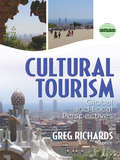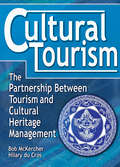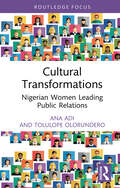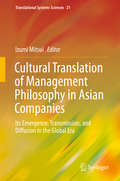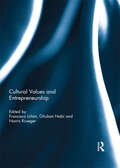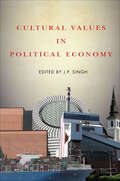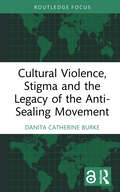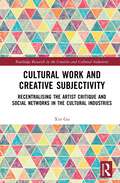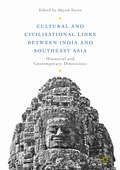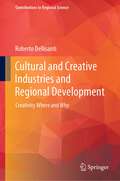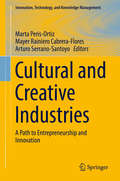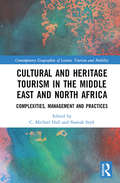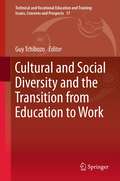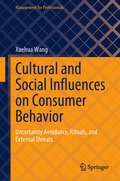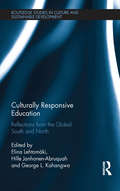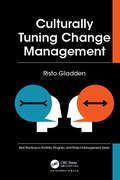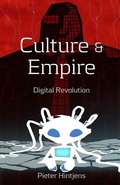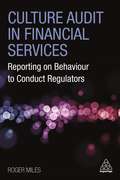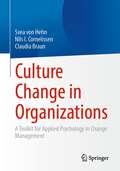- Table View
- List View
Cultural Tourism: Global and Local Perspectives (Tourism And Cultural Change Ser. #3)
by Greg RichardsA unique chance to explore different aspects of place, heritage, and tourismFor many nations around the world, cultural tourism is not only a major industry but also a support for national identity and a means for preserving heritage. Cultural Tourism: Global and Local Perspectives brings together in one volume interdisciplinary explora
Cultural Tourism: The Partnership Between Tourism and Cultural Heritage Management
by bob Mckercher hilary du crosExamine cultural tourism issues from both sides of the industry!Unique in concept and content, Cultural Tourism: The Partnership Between Tourism and Cultural Heritage Management examines the relationship between the sectors that represent opposite sides of the cultural tourism coin. While tourism professionals assess cultural assets for their profit potential, cultural heritage professionals judge the same assets for their intrinsic value. Sustainable cultural tourism can only occur when the two sides form a true partnership based on understanding and appreciation of each other's merits. The authors--one, a tourism specialist, the other, a cultural heritage management expert--present a model for a working partnership with mutual benefits, integrating management theory and practice from both disciplines.Cultural Tourism is the first book to combine the different perspectives of tourism management and cultural heritage management. It examines the role of tangible (physical evidence of culture) and intangible (continuing cultural practices, knowledge, and living experiences) heritage, describes the differences between cultural tourism products and cultural heritage assets, and develops a number of conceptual models, including a classification system for cultural tourists, indicators of tourism potential at cultural and heritage assets, and assessment criteria for cultural and heritage assets with tourism potential. Cultural Tourism examines the five main constituent elements involved in cultural tourism: cultural and heritage assets in tourism sites such as the Royal Palace in Bangkok, the Cook Islands, and Alcatraz Prison in San Francisco. tourism--what it is, how it works, and what makes it a success five different types of cultural tourists consumption of products, value adding, and commodification integrating the first four elements to satisfy the tourist, meet the needs of the tourism industry, and conserve the intrinsic value of the assetThough tourism and cultural heritage management professionals have mutual interests in the management, conservation, and presentation of cultural and heritage assets, the two sectors operate on parallel planes, maintaining an uneasy partnership with surprisingly little dialogue. Cultural Tourism provides professionals and students in each field with a better understanding of their own roles in the partnership, bridging the gap via sound planning, management, and marketing to produce top-quality, long-lasting cultural tourism products.Now translated into simplified Chinese.
Cultural Transformations
by John Mattone Nick VaidyaA Roadmap for Leadership and Cultural Transformation Throughout today's rapidly changing business world, top CEOs face two primary challenges: solving the leadership gap and creating a sustainable corporate culture. International leadership coach John Mattone and CEO magazine editor-in-chief Nick Vaidya unlock the keys to leadership development and cultural transformation through intimate interviews with fourteen CEOs from top organizations, including: Deloitte, Graybar, The North Face, HP Financial, Ovations Brands, Virtusa, and Bigcommerce. Culture was long thought to be merely a 'soft' resource in the corporate equation. However, more and more business leaders are beginning to recognize the necessity of culture when it comes to creating and sustaining long-term growth and change. What is the key to creating a strong business culture? Leadership. The best cultures start with CEOs who set the tone for the rest of the company, guiding others through the often difficult process of corporate transformation. You'll gain valuable insights, through experiences from the finest business minds, on how to introduce and sustain cultural change in your organization. Learn how successful CEOs came to realize their leadership potential Discover the key attributes that increase a leader's effectiveness Uncover your own leadership strengths and development needs Handle the primary obstacles to cultural transformation Address outdated mindsets and resistance to organizational change Mattone and Vaidya also draw upon their own extensive coaching and consulting experiences to provide a powerful and proven 6-Step Process for designing and implementing effective cultural transformations. This process enhances the other valuable tools in this comprehensive guide, so you can start building a positive organizational culture right away.
Cultural Transformations: Nigerian Women Leading Public Relations (Global PR Insights)
by Ana Adi Tolulope OlorunderoThis book is a groundbreaking exploration of the lived experiences of women in Nigeria’s public relations industry. Readers will gain a nuanced understanding of how Nigerian women navigate professional barriers, societal expectations, and the evolving demands of the public relations field. Key features include first-hand accounts from practitioners, thematic analyses on emotional labor, mentorship, and leadership challenges, and a metamodern perspective that bridges traditional and contemporary approaches.The book challenges global assumptions about gender in PR while reflecting on Nigeria’s unique cultural and regulatory context. Combining scholarly rigor with accessible storytelling, it serves as both a learning tool and a call to action for the global PR community, particularly in emerging markets like Nigeria, where gender equity in professional spaces remains a significant challenge.By highlighting strategies for overcoming systemic barriers, the book inspires students, researchers, and professionals to foster greater inclusivity and innovation in communication practices. Moreover, the book will also resonate with policymakers and professional associations focused on equity in the workplace.
Cultural Translation of Management Philosophy in Asian Companies: Its Emergence, Transmission, and Diffusion in the Global Era (Translational Systems Sciences #21)
by Izumi MitsuiThis book discusses management philosophy based on case studies in companies in Japan, Korea and China. In an era of increasing globalization and the internet society, it is time for companies to re-examine their mission and existence. Repeated corporate scandals and global environmental issues have revealed the need for CSR (corporate social responsibility) and business ethics. At the same time, cross-cultural conflicts in the workplace highlight the necessity for management to integrate multiple values. In other words, the importance of value in a company has to be reconsidered. This timely book re-evaluates the issue of management philosophy in the context of the global society. It approaches the issue of management philosophy from the perspective of keiei-jinruigaku, the anthropology of business administration, presenting interdisciplinary research consisting of fields such as management studies, anthropology, religious studies and sociology. By focusing on the phenomena of transmission of management philosophy to other areas by cultural translation, the book reveals the dynamic process of the global transmission of management philosophy.
Cultural Values and Entrepreneurship
by Francisco Liñán, Ghulam Nabi and Norris KruegerCultural Values and Entrepreneurship aims to broaden and deepen our understanding of which elements of ‘culture’ influence, or are influenced by, entrepreneurial activity. Differences in entrepreneurial activity among countries, and regions within those countries, are persistent and cannot be fully explained by institutional and economic variables. A substantial number of these differences have been attributed to culture, and it is clear that some socio-cultural practices, values and norms are more conducive to driving or inhibiting entrepreneurial intentions and activity. However, we need to dig deeper into ‘how’ and ‘why’ cultural practices, and underlying values and norms, matter in entrepreneurial action, in order to more fully understand the complexities of the processes, without making cross-cultural or cross-national generalisations. Unique cultural, national, and institutional contexts present different practices in terms of opportunities and challenges for driving entrepreneurial action. The contributions in this book consider some of the many different facets of the culture-entrepreneurship relationship, and offer valuable insights to our understanding of the field. This book was originally published as a special issue of Entrepreneurship & Regional Development.
Cultural Values in Political Economy
by J. P. SinghThe backlash against globalization and the rise of cultural anxiety has led to considerable re-thinking among social scientists. This book provides multiple theoretical, historical, and methodological orientations to examine these issues. While addressing the rise of populism worldwide, the volume provides explanations that cover periods of both cultural turbulence and stability. Issues addressed include populism and cultural anxiety, class, religion, arts and cultural diversity, global environment norms, international trade, and soft power. The interdisciplinary scholarship from well-known scholars questions the oft-made assumption in political economy that holds culture "constant," which in practice means marginalizing it in the explanation. The volume conceptualizes culture as a repertoire of values and alternatives. Locating human interests in underlying cultural values does not make political economy's strategic or instrumental calculations of interests redundant: the instrumental logic follows a social context and a distribution of cultural values, while locating forms of decision-making that may not be rational.
Cultural Violence, Stigma and the Legacy of the Anti-Sealing Movement
by Danita Catherine BurkeThis book injects nuance into the debate about the moral legitimacy of environmental and animal activism and explores how activism can lead to stigma and destruction of minority group identities, cultural practices and community structures. It takes readers back to ground zero of the anti-sealing movement – Newfoundland and Labrador. This book sheds light on the human costs of activists and the repercussions for vulnerable people when activism normalizes forms of violence as acceptable to achieve their desired outcomes. Inspired by Greenpeace Canada’s apology to Canadian Inuit, Indigenous and coastal peoples, this book brings into focus the local peoples who were targeted by activists and media outlets and left behind once the cultural and economic structures of the sealing industry and sealing practices were severely damaged by activist stigmatization and the global outcry against rural and coastal peoples and their practices. Drawing upon literature on cultural violence and archival research, this book will be of interest to scholars and researchers of international relations, development studies, public policy, sustainability studies and Indigenous studies.
Cultural Work and Creative Subjectivity: Recentralising the Artist Critique and Social Networks in the Cultural Industries (Routledge Research in the Creative and Cultural Industries)
by Xin GuThis book critically investigates the declining status of creative workers in contemporary societies following changes associated with the neoliberal creativity discourse – from the distribution of resources around cultural production to consumption, and from the management of ‘labour time’ to ‘life time’. These changes have narrowed career pathways for creative workers, resulting in exploitative working conditions for both professionals and amateurs. The contemporary cultural industries accentuate entrepreneurialism, informed by ‘social network markets’ and a capacity to engage technologised consumer culture. This book suggests that a radically different view is needed to understand how creative workers justify their continued participation in the cultural industries. It pays particular attention to the identities of marginalised cultural workers (underpaid or under-rewarded) and argues that cultural work cannot be understood as a route into entrapment by self-exploitation (sacrificial labour) nor as an abstract form of creative autonomy. Creative workers must engage the ‘artist critique’ to re-claim the social values of making culture as ‘public labour’. Bringing together theory and practice via contemporary case studies, this book is a significant contribution to research on the cultural economy and will be of interest to researchers in this field and practitioners in the management of cultural work.
Cultural Work and Higher Education
by Daniel Ashton Caitriona NoonanResponding to the creative economy's status as an industry, education and government priority, this edited volume brings together original contributions to examine the experiences and realities of working within a number of creative sectors and addresses how higher education can both enable students to pursue and critically examine work in the cultural industries. Debates on cultural work are garnering more interest than ever before and this volume presents critical discussion based on research findings from academics and policy-makers in the fields of media and cultural studies, enterprise, employability, psychology, and education. The volume addresses: what cultural work is and how higher education is connected with its growth as a sector; educational initiatives that see students gaining ever more detailed experiences and insights; the ways in which students and cultural workers position their identities; and the politics of access and issues of exclusion as they relate to industry networks, race and gender.
Cultural and Civilisational Links between India and Southeast Asia: Historical and Contemporary Dimensions
by Shyam SaranThe books presents the study undertaken by the ASEAN-India Centre (AIC) at Research and Information System for Developing Countries (RIS) on India’s cultural links with Southeast Asia, with particular reference to historical and contemporary dimensions.The book traces ancient trade and maritime links, Chola Empire and Southeast Asia, religious exchanges (the Hindu, Buddhist and Islamic heritage), language, scripts and folklore, performing arts, painting and sculpture, architecture, role of the Indian Diaspora, contemporary cultural interaction, etc.
Cultural and Creative Industries Policymaking: Sweden in the European Context (New Directions in Cultural Policy Research)
by Katja LindqvistThis book traces the emergence and development of cultural and creative industries (CCI) policy in Europe in the last 25 years. Why and how CCI policy has been designed and implemented in Europe is a central question of the book, in particular with regards to negotiations and relations between policy actors across established policy domains. There are many policy publications and reports on best practice and general descriptions of how policy systems work, fewer describe policy development over time and from a comparative perspective. Drawing mainly on research in policy studies, this book aims to improve knowledge of the dynamics of cultural and creative activities as well as that of policymaking in a changing policy landscape and increasingly cross-disciplinary research frameworks.
Cultural and Creative Industries and Regional Development: Creativity Where and Why (Contributions to Regional Science)
by Roberto DellisantiThis book explores the role of the cultural and creative industries (CCIs) as drivers of local economic development. More specifically, it builds on two novel perspectives in order to interpret the phenomenon. First, despite the general recognition that CCIs are innovative economic actors, their creative output is heterogeneous, as CCIs consist of extremely diverse industries, and the concept of innovation differs from sector to sector. Second, CCIs’ creativity is locally rooted, as the context provides innovative inputs for the development of creative ideas, binding creativity with well-established theories of the regional innovation literature. The book explores these new perspectives through a novel database on CCIs’ innovation at a fine industrial and regional scale.Building on these two ideas, the book is subdivided into three parts. In the first, a novel definition of creativity in CCIs is developed in which its heterogeneity and place-based nature are at the core. In turn, the second part addresses the phenomenon of localization choices in CCIs, highlighting their heterogeneous innovativeness and the filière which they belong to as key dimensions for the analysis. In the third part, the impact of CCIs on economic growth is explored. This book offers new evidence on the conditions under which CCIs cluster in space and stimulate development. It appeals to scholars in regional science, cultural economics and related fields, as well as policymakers and practitioners working in the cultural and creative industries.
Cultural and Creative Industries: A Path to Entrepreneurship and Innovation (Innovation, Technology, and Knowledge Management)
by Marta Peris-Ortiz Mayer Rainiero Cabrera-Flores Arturo Serrano-SantoyoThis book examines the ways in which cultural and creative industries can drive entrepreneurship, innovation, sustainability and overall regional development. It will address such issues as (1) the technical (tangible) components of creative and cultural industries in relation to innovation; (2) the intangible components of creative and cultural industries in relation to services provided; (3) the relationship between tangible and intangible components and economic and social innovation; and (4) the ways in which creative and cultural industries effect and influence regional sustainability and development.Cultural and creative industries and the creative economy as a whole have been increasingly prevalent in research literature because of their role in driving economic and social development. Cultural and creative industries also enable other forms of entrepreneurship and innovation beyond the traditional, technology-based focus of innovation, thereby enhancing regional growth and development through these channels. The contributions presented in this book discuss the main issues, challenges, opportunities and trends of cultural and creative industries through conceptual analysis and cases studies from different world regions. Featuring research from industries such as art, health care, beer and wine and education, this book provides researchers, academics, professionals and policy makers with a detailed examination of the development and potential of cultural and creative industries in regional and global economies.
Cultural and Heritage Tourism in the Middle East and North Africa: Complexities, Management and Practices (Contemporary Geographies of Leisure, Tourism and Mobility)
by Milenka Linneth Argote Cusi León Darío Parra BernalThis is the first book to provide a comprehensive account of cultural and heritage tourism in the Middle East and North Africa (MENA) region and the many complexities that heritage sites and tourist attractions face. The MENA region has long been regarded as the cradle of Western and Arab civilisation and is the home of many of the world’s major religions. Because of this, the region is rich in heritage sites that serve as major tourist attractions and as icons of national, cultural and religious identity. However, as this book examines, heritage in the region is simultaneously highly contested and has even become a target for terrorism creating a situation that brought major challenges for heritage management and sustainable tourism development. Many of the region’s innumerable cultural sites are threatened, in some cases by overuse, in others by neglect and, in many, simply by the pressures of economic development. This book is therefore of interest not only to heritage managers and policy makers but those academics who seek to address the delicate balance between tourism development, communities and the tourists who visit such sites in a turbulent but highly significant region of the world.
Cultural and Social Diversity and the Transition from Education to Work (Technical and Vocational Education and Training: Issues, Concerns and Prospects #17)
by Guy TchibozoThis edited volume provides multidisciplinary and international insights into the policy, managerial and educational aspects of diverse students' transitions from education to employment. As employers require increasing global competence on the part of those leaving education, this research asks whether increasing multiculturalism in developed societies, often seen as a challenge to their cohesion, is in fact a potential advantage in an evolving employment sector. This is a vital and under-researched field, and this new publication in Springer's Technical and Vocational Education and Training series provides analysis both of theory and empirical data, submitted by researchers from nine nations including the USA, Oman, Malaysia, and countries in the European Union. The papers trace the origins of business demand for diversity in their workforce's skill set, including national, local and institutional contexts. They also consider how social, demographic, cultural, religious and linguistic diversity inform the attitudes of those seeking work--and those seeking workers. With clear suggestions for future research, this work on a topic of rising profile will be read with interest by educators, policy makers, employers and careers advisors.
Cultural and Social Influences on Consumer Behavior: Uncertainty Avoidance, Rituals, and External Threats (Management for Professionals)
by Xuehua WangThis book explores how cultural and social influences affect consumer decision making with a focus on uncertainty avoidance, rituals, and external threats. Indeed, uncertainty avoidance can exert significant influence on consumer behavior. For example, consumers in a culture with high uncertainty avoidance may show less positive attitudes towards new products than those in a culture with low uncertainty avoidance. Prior cultural research has mainly focused on how individualism/collectivism or power distance belief influences consumer attitudes and behaviors at an individual level, while seldom does research investigate the effect of uncertainty avoidance on consumption. This book examines how uncertainty avoidance affects superstitious consumption as well as its underlying mechanism and boundary condition. Rituals, as a component of culture, can affect consumer behaviors. However, few studies have shedded light on how repeating rituals can affect consumers’ willingness to use the products involved in the ritual. Consumer behavior is complex. Consumers are surrounded with various external threats such as health, economic, and informational threats, while prior research has primarily focused on health threats. Beyond this, inter-client conflicts, as a special type of social threat, can also affect consumption experience. In all, this book aims to examine how uncertainty avoidance, rituals and external threats influence consumer attitudes and behaviors. In this book, new research models would be developed. This book enriches our understanding on how cultural and social influences affect consumer decision making and provides insights for both researchers and practitioners in marketing.
Cultural and Tourism Innovation in the Digital Era: Sixth International IACuDiT Conference, Athens 2019 (Springer Proceedings in Business and Economics)
by Vicky Katsoni Thanasis SpyriadisThis book explores a wide range of emerging cultural, heritage, and other tourism issues that will shape the future of hospitality and tourism research and practice in the digital and innovation era. It offers stimulating new perspectives in the fields of tourism, travel, hospitality, culture and heritage, leisure, and sports within the context of a knowledge society and smart economy. A central theme is the need to adopt a more holistic approach to tourism development that is aligned with principles of sustainability; at the same time, the book critically reassesses the common emphasis on innovation as a tool for growth-led and market-oriented development. In turn, fresh approaches to innovation practices underpinned by ethics and sustainability are encouraged, and opportunities for the exploration of new research avenues and projects on innovation in tourism are highlighted. Based on the proceedings of the Sixth International Conference of the International Association of Cultural and Digital Tourism (IACuDiT) and edited in collaboration with IACuDiT, the book will appeal to a broad readership encompassing academia, industry, government, and other organizations.
Culturally Responsive Education: Reflections from the Global South and North (Routledge Studies in Culture and Sustainable Development)
by Elina Lehtomäki Hille Janhonen-Abruquah George KahangwaCulturally Responsive Education: Reflections from the Global South and North examines culturally responsive education’s contribution to sustainable development and explores ways in which educational practitioners respond to cultures in and around educational contexts. This book argues that cultural responsiveness in education is invaluable for sustainability in and throughout education, and explores methods with which to deepen the understanding of the values and intercultural dialogue constantly present in education. Using a number of international and multidisciplinary studies, the authors offer a novel perspective on to the consideration of diversity throughout education and provide a valuable contribution to the ongoing global and national debate surrounding the UN Sustainable Development Goal initiative. With a focus on collaboration, this edited volume is vital reading for scholars, teachers and students of education, sociology, and development studies as well as education professionals. The book will also be of interest to education policy -makers and international and non-governmental organizations.
Culturally Responsive and Socially Just Leadership in Diverse Contexts: From Theory to Action
by Ann E. LopezThis book offers workable frameworks and theory that school leaders can use to guide their work and engage in critical reflection. Lopez reconceptualises student engagement from an equity and diversity perspective and looks at ways that leaders can be supported on their journey through collaborative mentorship, while bridging the theory to practice gap.
Culturally Tuning Change Management (Best Practices in Portfolio, Program, and Project Management)
by Risto GladdenManaging change across cultures can be tricky, and universal approaches to change management may not serve their purpose in every cultural setting. This book examines the cultural dimensions that can influence the perceptions of and reactions to change in different cultural contexts and highlights the benefits of developing and applying cultural mindfulness when planning and running cross-cultural change initiatives. It offers practical advice to project and change management teams and leaders for developing Cultural Intelligence, tailoring plans to consider any cultural variables that could be barriers to (or catalysts for) effective change, and applying facilitating strategies.
Culture & Empire: Digital Revolution
by Pieter HintjensThe whole planet is getting connected and building vast new communities. Our new communities are a very real challenge to old power and old money. And old money -- after its War on Drugs and War on Terror -- is now launching its War on the Internet. What is going on, and where will this lead us? Pieter Hintjens tells all in this vast story of Culture & Empire: Digital Revolution.
Culture Analytics: An Evidence-Based Approach to Company Culture
by Hani NabeelHow can I take a data-driven approach to company culture? What should I measure and which metrics should I focus on? How can I use people analytics and behavioural science impact culture?Based on insights from the largest ever behavioural research study which examined the organizational impact of 220+ behaviours from 60 organizations, across 61 countries, Culture Analytics provides an evidence-based approach to organizational culture. It outlines the leading and lagging culture indicators, explains how to identify actionable insights from your people and culture data as well as how to apply predictive analytics to company culture. There is also guidance on the 30 employee behaviours which have the most impact on company culture and how to apply behavioural science interventions to drive these in your organization. The second part of the book covers key areas where culture analytics can be applied to drive business performance. These areas include talent acquisition and retention, employee engagement, EDI (equity, diversity and inclusion), wellbeing, psychological safety as well as resilience, strategy, innovation, change management and risk. Full of practical advice, this book also includes real world examples from Barclays, Pfizer, American Airlines, EDF Energy, Saudi Telecom Company, Cisco and Ethiad Airways. Making the complex world of people analytics and behavioural science accessible and applicable to all senior HR professionals and business leaders, Culture Analytics shows how to take a robust, evidence-based approach to company culture to drive workforce and organizational performance and deliver tangible business value.
Culture Audit in Financial Services: Reporting on Behaviour to Conduct Regulators
by Dr Roger MilesIn the next wave of conduct regulation in financial markets, from 2021 conduct regulators in the UK and elsewhere expect firms to produce evidence on how they are improving behaviour and culture. Facing this, many practitioners are anxious that their current reporting and management information (MI) are irrelevant to meeting as-yet unclear regulatory expectations.This book provides the insights and tools firms need to report on culture, securing both enhanced business value and the regulator's approval. Culture is now seen as a key contributor to good governance, feeding into existing discourse on environmental, social and governance (ESG) factors and the emerging dialogue on 'non-financial (mis)conduct', but conventional measures of business quality are unfit for the new reporting agenda. Culture Audit in Financial Services follows the arc of 'behavioural regulation' to examine what the regulator really wants, before offering guidance on how culture audit differs from conventional auditing, how to put the latest pure-research findings to work, and the key features of well-designed conduct and culture reports. Written by an impartial author and a variety of contributors with extensive experience working with practitioners, regulators, and many of the world's finest academic initiatives, this book is filled with practical, grounded advice on how best to approach this new challenge and avoid infractions.
Culture Change in Organizations: A Toolkit for Applied Psychology in Change Management
by Nils I. Cornelissen Claudia Braun Svea von HehnCulture change in four steps!This extraordinary and well-illustrated book offers you valuable insights and tools for the four iterative phases of cultural change. It serves as a reference and shows you how large-scale change happens through viral change.It offers valuable insights and combines important findings from applied psychology, case studies and practical instructions for action with valuable insights from behavioral economics and neuroscience. ContentsConcrete tools for the four iterative phases of cultural changePractical case studies from the corporate world, including digital change and New WorkIn-depth background knowledge on behavioral and mindset changeTips for culture change agents on how to use emotional intelligence and mindfulness to build resilience and master change in the face of resistanceHelpful didactics through illustrations, summaries, checklists of success factors, background,reflection and exercise boxesTarget groupsExecutives, human resources professionals, people from organizational development, consultants in startups, mid-sized companies and global international corporations as well as public organizationsAuthorsDr. Svea von Hehn has been working internationally as a management consultant (including for McKinsey & Company) since 1999. She holds a PhD in Psychology, is a multi-certified systemic coach and is a partner at RETURN ON MEANING.Nils I. Cornelissen has been working internationally as a management consultant (including for McKinsey & Company) since 2003. He holds a degree in Communications and a master's degree in Psychology and Sociology. He is a certified coach as well as a facilitator and partner at RETURN ON MEANING.Claudia Braun has been working internationally as a management consultant (including for McKinsey & Company) since 2007. She holds a degree inInternational Business Administration, a Master of Public Administration, a Master of Public Policy as well as various certifications. She is a partner at RETURN ON MEANING.The translation was done with the help of artificial intelligence. A subsequent human revision was done primarily in terms of content.
